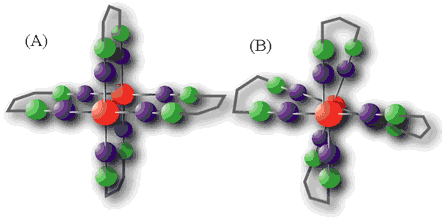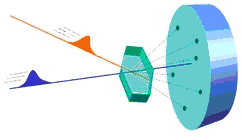X-Ray Pump-Probe Instrument
PURPOSE: This instrument, using the ultrabright, ultrashort x-ray pulses from LCLS, will permit a large class of dynamical processes in molecules and condensed matter systems to be studied directly, with atomic spatial resolution and sub-picosecond time resolution.
Biological, chemical, and physical processes involve the time-dependent transformation of matter on the atomic scale. Examples of these processes with technological and environmental significance are the photosynthetic generation of chemical energy, the catalytic production of fertilizer, the chemical degradation of pollutants, and the melting of ice. These structural transformations involve the motion of electrons, atoms, and molecules over very short distances (10-9 m) and very fast time scales (10-12 s). Though much has been learned about these dynamical processes from previous work, particularly studies using x-rays and lasers, no existing technology can provide direct observation of atomic motions on ultrafast time scales.
Specifically, this instrument will enable the study of stimulated changes in the structures of molecules and condensed matter systems. The changes will typically be stimulated by a short pulse of optical laser light, and observed using x-ray diffraction. Femtosecond-level synchronization between the optical laser and the LCLS x-ray pulse will allow sub-picosecond time resolution.
Examples of studies with this instrument:
- Dynamics of photo-induced phase transitions: Optical manipulation of solids can lead to photo-induced phase transitions on the ultrafast time scale. These materials possess potential technological importance as ultrafast optical signal processing materials.
- Dynamics of photoactive proteins: The variability and efficiency of proteins make them powerful molecular foundries. To understand how a protein functions at a mechanistic level of detail, it is necessary to measure in real time the nuclear motions that accompany its function.
- Dynamics of photo-initiated electron transfer reactions: Electron transfer reactions reside at the center of many important chemical, biological, and technological processes, including photosynthesis and the operation of photovoltaics for solar energy conversion.

Schematic representations of the ground state structure (A) and the excited state structure (B) of a bridged bimetallic complex. Electronic excitation causes the metal-metal bond length to shorten and rotate. These excited state molecules can catalyze a variety of chemical reactions including H2 production.
INSTRUMENT CONCEPT: The pump-probe instrument will predominantly use a fast optical laser to generate transient states of matter, and the hard x-ray pulses from the LCLS to probe the structural dynamics initiated by the laser excitation. The laser pump will have the ability to conduct precise optical manipulations, in order to create the desired excited states.

An ultrafast laser pulse (yellow) excites a brief change in the positions of the atoms in the sample. This change is studied using diffraction of the LCLS x-ray pulse (blue), which follows the laser pulse after a precise time delay. Figure courtesy of the Centre for Molecular Movies, established by the Danish National Research Foundation.
The instrument design will emphasize versatility. To maximize the range of phenomena that can be excited, it will be necessary to be able to manipulate the laser pulse energy, frequency, and temporal profile. X-ray scattering will be the dominant tool for probing the laser-induced changes, while x-ray absorption and emission spectroscopy will probe changes in electronic structure. These experiments require the union of four experimental capacities: the generation and delivery of x-ray and laser pulses to the sample, the preparation of the excited state in the sample, and the detection of the x-ray scattering pattern or x-ray absorption and emission.
UNIQUENESS: Facilities for carrying out time-resolved x-ray scattering measurements exist at every synchrotron light source, since this is such an important and wide field of research. However, no existing facility can come close to matching the brightness and time resolution of this instrument at LCLS. This will be the only instrument capable of mapping out the progress of complex structural changes associated with technologically-important chemical reactions on the sub-picosecond time scale that is most relevant for them.
